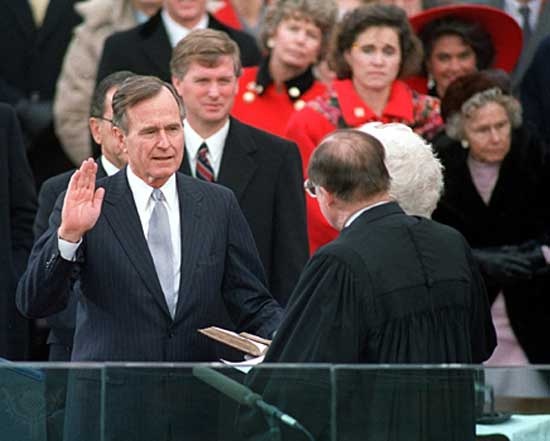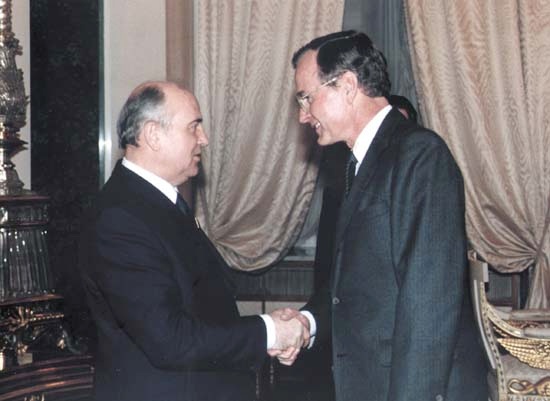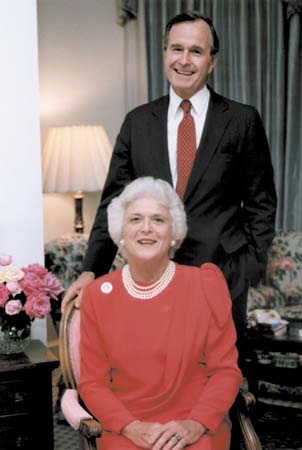Bush, George
president of United States
Introduction
in full George Herbert Walker Bush
born June 12, 1924, Milton, Massachusetts, U.S.
 politician and businessman who was vice president of the United States (1981–89) and the 41st president of the United States (1989–93). As president, Bush assembled a multinational force to compel the withdrawal of Iraq from Kuwait in the Persian Gulf War. (For a discussion of the history and nature of the presidency, see presidency of the United States of America.)
politician and businessman who was vice president of the United States (1981–89) and the 41st president of the United States (1989–93). As president, Bush assembled a multinational force to compel the withdrawal of Iraq from Kuwait in the Persian Gulf War. (For a discussion of the history and nature of the presidency, see presidency of the United States of America.)Early life and career
Bush was the son of Prescott Sheldon Bush, an investment banker and U.S. senator from Connecticut, and Dorothy Walker Bush, scion of a prominent St. Louis, Missouri, family. (Her father established the amateur golf competition known as the Walker Cup.) The young Bush grew up in Greenwich, Connecticut, and attended private schools there and in Andover, Massachusetts. Upon graduation from Phillips Academy, Andover, he joined the U.S. Naval Reserve. He served from 1942 to 1944 as a torpedo bomber pilot on aircraft carriers in the Pacific during World War II, flying some 58 combat missions; he was shot down by the Japanese in 1944. For his service he won the Distinguished Flying Cross. In January 1945 he married Barbara Pierce (Barbara Bush (Bush, Barbara)).
Following the family tradition, Bush attended Yale University, graduating in 1948. His membership in the Skull and Bones secret society there later became an issue that his critics used as evidence of elitism. Rejecting a position in his father's firm, he moved with his young family to Texas and became a salesman of oil-field supplies. He cofounded the Bush-Overbey Oil Development Company (1951), the Zapata Petroleum Corporation (1953), and the Zapata Off-Shore Company (1954). In 1959 he became active in the Republican Party in Houston, and after losing a campaign for the U.S. Senate to Democrat Ralph Yarborough in 1964, Bush was elected in 1966 to a safely Republican seat in the U.S. House of Representatives. He gave up the seat in 1970 to run again for the Senate. He was defeated again, this time by Democrat Lloyd Bentsen, Jr. Shortly after his defeat, Bush was appointed by President Richard M. Nixon (Nixon, Richard M.) to serve as U.S. ambassador to the United Nations (UN; 1971–72). In 1973, as the Watergate Scandal was erupting, Bush became chairman of the Republican National Committee. In this post, he stood by President Nixon until August 1974, when he joined a growing chorus of voices calling on the president to resign. Later that year, President Gerald R. Ford (Ford, Gerald R.), who had nominated Nelson Rockefeller (Rockefeller, Nelson Aldrich) as his vice president, named a disappointed Bush chief of the U.S. Liaison Office in Beijing—which was then the senior U.S. representative in China, because relations between the two countries did not permit the exchange of ambassadors. He served in this capacity until he was asked to head the Central Intelligence Agency in 1976. As CIA director, Bush took steps to ensure that the agency's activities did not exceed congressional authorization. When Jimmy Carter (Carter, Jimmy) took office in 1977, Bush resigned and returned to Texas, where in 1979 he announced his candidacy for president.
Vice presidency
 After declaring that his opponent, the more popular and conservative Ronald W. Reagan (Reagan, Ronald W.), would have to practice “voodoo economics” in order to increase federal revenue by lowering taxes, Bush abandoned his campaign for the Republican Party's presidential nomination in May 1980 and threw his support behind Reagan, who then chose Bush as his running mate. The Reagan-Bush ticket defeated the Democratic ticket of Jimmy Carter and Walter Mondale (Mondale, Walter) by a wide margin in the 1980 presidential election. Bush won Reagan's loyalty, and the two were reelected in 1984 for a second term in an even greater landslide than that of 1980.
After declaring that his opponent, the more popular and conservative Ronald W. Reagan (Reagan, Ronald W.), would have to practice “voodoo economics” in order to increase federal revenue by lowering taxes, Bush abandoned his campaign for the Republican Party's presidential nomination in May 1980 and threw his support behind Reagan, who then chose Bush as his running mate. The Reagan-Bush ticket defeated the Democratic ticket of Jimmy Carter and Walter Mondale (Mondale, Walter) by a wide margin in the 1980 presidential election. Bush won Reagan's loyalty, and the two were reelected in 1984 for a second term in an even greater landslide than that of 1980.As vice president, Bush traveled more than a million miles as the administration's representative. When asked about his involvement in the Iran-Contra Affair—in which the Reagan administration, in violation of congressional edict, used funds from the illegal sale of arms to Iran to fund Contra rebels fighting the Marxist government of Nicaragua—Bush claimed that he was “out of the loop,” though he did admit knowing about the arms sale to Iran. In 1987 he published an autobiography, Looking Forward (written with Victor Gold).

 An early and leading candidate for the Republican Party's nomination for the presidency in 1988, he secured the nomination and, together with his running mate, Dan Quayle (Quayle, Dan), defeated the Democratic candidate, Michael Dukakis (Dukakis, Michael S.), winning 53 percent of the popular vote to Dukakis's 46 percent. Although Bush had called for “a kinder, and gentler, nation” in his speech accepting the nomination, his campaign was negative, at one point criticizing Dukakis with a phrase—“card-carrying member of the American Civil Liberties Union”—reminiscent of that used by Senator Joe McCarthy (McCarthy, Joseph R.). Bush also won supporters with his pledge to continue the Reagan economic program, repeatedly stating: “Read my lips, no new taxes!” (See primary source document: Inaugural Address (George Bush: Inaugural Address).)
An early and leading candidate for the Republican Party's nomination for the presidency in 1988, he secured the nomination and, together with his running mate, Dan Quayle (Quayle, Dan), defeated the Democratic candidate, Michael Dukakis (Dukakis, Michael S.), winning 53 percent of the popular vote to Dukakis's 46 percent. Although Bush had called for “a kinder, and gentler, nation” in his speech accepting the nomination, his campaign was negative, at one point criticizing Dukakis with a phrase—“card-carrying member of the American Civil Liberties Union”—reminiscent of that used by Senator Joe McCarthy (McCarthy, Joseph R.). Bush also won supporters with his pledge to continue the Reagan economic program, repeatedly stating: “Read my lips, no new taxes!” (See primary source document: Inaugural Address (George Bush: Inaugural Address).)Presidency
 Upon assuming office, Bush made a number of notable senior staff appointments, among them that of General Colin Powell (Powell, Colin) to chairman of the U.S. Joint Chiefs of Staff. His other important policy makers included James Baker as secretary of state and William Bennett as director of the Office of National Drug Control Policy. In the course of his presidency, he also nominated two Supreme Court (Supreme Court of the United States) justices, David H. Souter (Souter, David Hackett) (to replace the retiring William J. Brennan (Brennan, William)) and the more controversial Clarence Thomas (Thomas, Clarence) (to replace Thurgood Marshall (Marshall, Thurgood)).
Upon assuming office, Bush made a number of notable senior staff appointments, among them that of General Colin Powell (Powell, Colin) to chairman of the U.S. Joint Chiefs of Staff. His other important policy makers included James Baker as secretary of state and William Bennett as director of the Office of National Drug Control Policy. In the course of his presidency, he also nominated two Supreme Court (Supreme Court of the United States) justices, David H. Souter (Souter, David Hackett) (to replace the retiring William J. Brennan (Brennan, William)) and the more controversial Clarence Thomas (Thomas, Clarence) (to replace Thurgood Marshall (Marshall, Thurgood)).From the outset of his presidency, however, Bush demonstrated far more interest in foreign than domestic policy. In December 1989, he ordered a military invasion of Panama in order to topple that country's leader, General Manuel Antonio Noriega (Noriega, Manuel), who—though at one time of service to the U.S. government—had become notorious for his brutality and his involvement in the drug trade. The invasion, which lasted four days, resulted in hundreds of deaths, mostly of Panamanians, and the operation was denounced by both the Organization of American States (American States, Organization of) and the UN General Assembly.
 Bush's presidency coincided with world events of large proportion, including the collapse of communism in eastern Europe and the Soviet Union and the reunification of Germany. In November 1990 Bush met with Soviet leader Mikhail Gorbachev (Gorbachev, Mikhail) in Paris and signed a mutual nonaggression pact, a symbolic conclusion to the Cold War. They signed treaties sharply reducing the number of weapons that the two superpowers had stockpiled over the decades of Cold War hostility.
Bush's presidency coincided with world events of large proportion, including the collapse of communism in eastern Europe and the Soviet Union and the reunification of Germany. In November 1990 Bush met with Soviet leader Mikhail Gorbachev (Gorbachev, Mikhail) in Paris and signed a mutual nonaggression pact, a symbolic conclusion to the Cold War. They signed treaties sharply reducing the number of weapons that the two superpowers had stockpiled over the decades of Cold War hostility.In August 1990, Iraq invaded and occupied Kuwait. Bush led a worldwide UN-approved embargo against Iraq to force its withdrawal and sent a U.S. military contingent to Saudi Arabia to counteract Iraqi pressure and intimidation. Perhaps his most significant diplomatic achievement was the skillful construction of a coalition of western European and Arab states against Iraq. Over the objections of those who favoured restraint, Bush increased the U.S. military presence in the Persian Gulf (Persian Gulf War) region to about 500,000 troops within a few months. When Iraq failed to withdraw from Kuwait, he authorized a U.S.-led air offensive that began on January 16–17, 1991. The ensuing Persian Gulf War culminated in an Allied ground offensive in late February that decimated Iraq's armies and restored Kuwait's independence. (See primary source document: Operation Desert Storm (George Bush: Operation Desert Storm).)
On the strength of his victory over Iraq and his competent leadership in foreign affairs, Bush's approval rating soared to about 90 percent. This popularity soon waned, however, as an economic recession that began in late 1990 persisted into 1992. Throughout this period, Bush showed much less initiative in domestic affairs, though he initially worked with Congress in efforts to reduce the federal government's continuing large budget deficits. A moderate conservative, he made no drastic departures from Reagan's policies—except in taxes. In 1990, in a move that earned him the enmity of his conservative supporters and the distrust of many voters who had backed him in 1988, he reneged on his “read my lips” pledge and raised taxes in an attempt to cope with the soaring budget deficit.
 Bush's policy reversal on taxation and his inability to turn around the economy—his failure to put across what he called “the vision thing” to the American public—ultimately proved his downfall. Bush ran a lacklustre campaign for reelection in 1992. He faced a fierce early challenge from Patrick Buchanan (Buchanan, Patrick J.) in the Republican primary and then lost votes in the general election to third-party candidate Ross Perot (Perot, Ross). Meanwhile, Bush's Democratic opponent, Bill Clinton (Clinton, Bill) of Arkansas, hammered away at the issue of the deteriorating economy. In the oft-repeated words of Clinton strategist James Carville, the key issue of the day was “the economy, stupid!” Bush, the first vice president since Martin Van Buren (Van Buren, Martin) in 1836 to succeed directly to the presidency via an election rather than the death of the incumbent, lost to Clinton by a popular vote of 37 percent to Clinton's 43 percent; Perot garnered an impressive 19 percent of the vote. In trying to explain how Bush—always an active man and an avid jogger—could have run such a lifeless campaign and performed so poorly in formal debates with Clinton, some analysts postulated that Bush was hampered by medication he had been taking to treat his atrial fibrillation, reportedly caused by Graves disease. Bush's campaign managers vehemently denied the theory.
Bush's policy reversal on taxation and his inability to turn around the economy—his failure to put across what he called “the vision thing” to the American public—ultimately proved his downfall. Bush ran a lacklustre campaign for reelection in 1992. He faced a fierce early challenge from Patrick Buchanan (Buchanan, Patrick J.) in the Republican primary and then lost votes in the general election to third-party candidate Ross Perot (Perot, Ross). Meanwhile, Bush's Democratic opponent, Bill Clinton (Clinton, Bill) of Arkansas, hammered away at the issue of the deteriorating economy. In the oft-repeated words of Clinton strategist James Carville, the key issue of the day was “the economy, stupid!” Bush, the first vice president since Martin Van Buren (Van Buren, Martin) in 1836 to succeed directly to the presidency via an election rather than the death of the incumbent, lost to Clinton by a popular vote of 37 percent to Clinton's 43 percent; Perot garnered an impressive 19 percent of the vote. In trying to explain how Bush—always an active man and an avid jogger—could have run such a lifeless campaign and performed so poorly in formal debates with Clinton, some analysts postulated that Bush was hampered by medication he had been taking to treat his atrial fibrillation, reportedly caused by Graves disease. Bush's campaign managers vehemently denied the theory.In his last weeks in office, Bush ordered a U.S. military-led mission to feed the starving citizens of war-torn Somalia, thereby placing U.S. marines in the crossfire of warring factions and inadvertently causing the deaths of 18 soldiers. Equally as controversial was his pardoning of six Reagan administration officials charged with illegal actions associated with the Iran-Contra Affair.
Retirement
 Bush and his wife, Barbara, returned to Houston on the day of Clinton's inauguration and had little formal involvement with the Republican Party thereafter. His son George W. Bush (Bush, George W.), a popular two-term governor of Texas, successfully ran for president in 2000, becoming only the second son of a president to win the White House; the first was John Quincy Adams (Adams, John Quincy) in 1824. Another son, Jeb, was elected governor of Florida in 1998.
Bush and his wife, Barbara, returned to Houston on the day of Clinton's inauguration and had little formal involvement with the Republican Party thereafter. His son George W. Bush (Bush, George W.), a popular two-term governor of Texas, successfully ran for president in 2000, becoming only the second son of a president to win the White House; the first was John Quincy Adams (Adams, John Quincy) in 1824. Another son, Jeb, was elected governor of Florida in 1998.Cabinet of President George Bush
Cabinet of President George Bush Cabinet of President George BushThe table provides a list of cabinet members in the administration of President George Bush.
Additional Reading
The speeches and statements of George Bush during his presidency are contained in Public Papers of the Presidents of the United States: George Bush, 8 vol. (1990–93). Bush's campaign is narrated in Jack W. Germond and Jules Witcover, Whose Broad Stripes and Bright Stars?: The Trivial Pursuit of the Presidency, 1988 (1989); and Richard Ben Cramer, What It Takes: The Way to the White House (1992). Colin Campbell and Bert A. Rockman (eds.), The Bush Presidency: First Appraisals (1991), provides a collection of essays analyzing different aspects of the Bush administration's first two years. Michael Duffy and Dan Goodgame, Marching in Place: The Status Quo Presidency of George Bush (1992); and Dilys M. Hill and Phil Williams (eds.), The Bush Presidency: Triumphs and Adversities (1994), critique Bush's leadership and domestic policy while praising his conduct of foreign affairs. Charles Tiefer, The Semi-Sovereign Presidency: The Bush Administration's Strategy for Governing Without Congress (1994), discusses the difficulties Bush experienced in dealing with a Democrat-controlled Congress.Pamela Kilian, Barbara Bush (1992); and Barbara Bush, Barbara Bush: A Memoir (1994), recount the first lady's public and private life.
- Simon, Sir John
- Simonson, Lee
- Simon Stevin
- Simonstown
- Simons, Walter
- Simon the Apostle, Saint
- Simon van der Meer
- Simon Vestdijk
- Simon Vouet
- Simon Wiesenthal
- Simon Willard
- simony
- simoom
- simple harmonic motion
- Simple sentences-first pattern
- Simple sentences-second pattern
- Simplicius Of Cilicia
- Simplicius, Saint
- Simplon Pass
- Simplon Tunnel
- Simpson, Christopher
- Simpson Desert
- Simpson, George Gaylord
- Simpson, Louis
- Simpson, Matthew